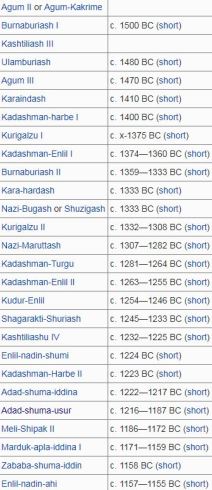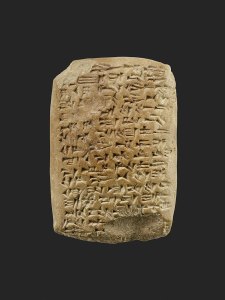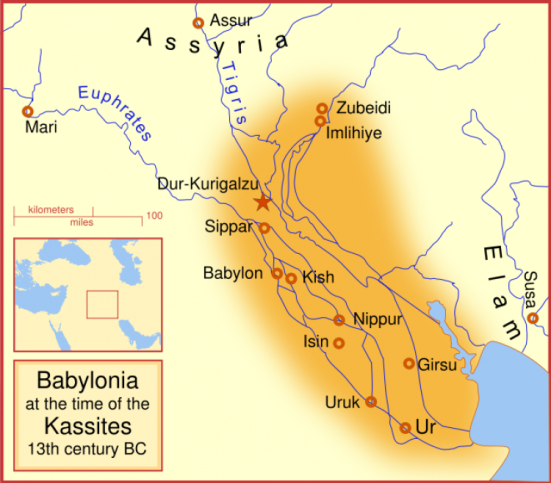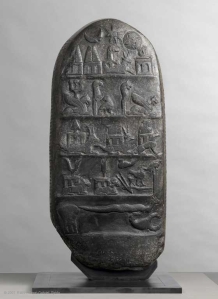After the Hittites under Mursili I sacked Babylon and retreated, the city and its environment were left without a ruler. In the south of Babylonia, the so-called Sealand Dynasty (or Second Dynasty of Babylon) came to power, cutting off the rest of Mesopotamia from the trade routes going over the Persian Gulf to India. Probably they also ruled the city of Babylon for a while, however, that did not last long, since the power vacuum in Babylonia proper was quickly filled by a new dynasty, one that would reign for more than three centuries: the First Kassite Dynasty.

A reconstruction of the Kassite Dynasty
Where exactly the Kassites came from is still debated today. The most accepted view is that they originally lived in the regions at the foot of the Zagros-mountains to the north-east of Babylonia. Unfortunately we know barely anything about the language they spoke, since it was almost solely preserved in names. Kassites are attested in Babylonian sources from the 18th century BC onwards, not only as hostile groups living at the margins of Babylonian society but as mercenaries in the army and agricultural labour forces as well. Some researchers associate the success of the people with the use of two wheeled horse-drawn chariots, which were started to be used around the same time. It is impossible, though, to make a direct connection between both phenomenons.
Due to a lack of sources, it is difficult to reconstruct the political history of the period. For the first century of their reign, there is almost no documentation about the Kassite rulers. Later, the material becomes more abundant, but there are two problems with it: the Kassites abolished the practice of using year names – making it very hard to set a chronological frame – and most of the texts remain unpublished today, including the largest part of the 12000 tablet-counting archive from the city of Nippur. Most of what we learn as “Kassite history” comes from (much!) later compositions, but it is uncertain to which degree those (hi)stories are correct.

Letter from the king of Tyre to the Egyptian pharaoh
Even though often considered as a “Dark Age” in Mesopotamian history, the region flourished under Kassite rule, as can be gleaned from archives that were found outside of Mesopotamia. In Egypt, the Amarna-archive offers valuable insights in the diplomatic relations of the time: correspondence between the Kassite king and the Egyptian pharaoh was written in Akkadian, which served as a lingua franca at this time. In Hattusha, capital of the Hittite empire, another smaller archive of Akkadian texts was found. It is clear that Babylonia was one amongst the other “great powers”: the Kassite kings addressed their Egyptian and Hittite colleagues with “brother”, sent them lavish gifts and married their daughters or sisters.


Kudurru of Meli-Shipak II (Louvre)
The wealth of the state is visible too in the many refurbishments taking place in its cities, and not in the least in the creation of a new capital, Dur-Kurigalzu, that lay on the trade route to the Diyala, by which lapis lazuli (an important diplomatic gift) was imported. In fact, the country was so rich under the Kassites, that some Assyriologists have claimed that gold became the standard for business transactions for a while, unique in Mesopotamian history (silver was more common). One kind of source attests very well to the fact that wealth did not remain in the kings’ hands but was shared with local institutions and persons: kudurrus (Akkadian “boundary”) are small stone steles which record land grants to private persons but temple institutions as well. They contained an inscription describing the donation, a curse formula, and visual representations of different deities ranged from great gods (upper part) to local gods (lower part). Kudurrus were mostly placed in temples – they are thus not real “boundary stones” delimiting fields. Some of the steles were retrieved in Susa (Iran), where they had been brought as booty by the Elamite king Shutruk-Nahhunte in ca. 1160 BC (as well as the Codex Hammurabi and the Stele of Naram-Sîn).
Apart from kudurrus, we do not have much contemporary evidence of the cultural flourishing that characterised the period, even though we know that there must have been a huge creative production at the time. The corpus of Babylonian literary works that is preserved in later sources attests to the intense scribal activity that took place in the Kassite period, when “standard” editions of “classical” stories were created and new compositions were made. Furthermore, a new religious concept arose: the personal god, who served as an intermediary between a normal human and the great gods. Some famous stories that originated at the time show how people started to think more critically about the human-god relationship, for example Ludlul bel nemeqi (“I will praise the lord of wisdom”):
“I wish I knew that these things were pleasing to a god. What seems good to oneself could be an offence to a god, what in one’s own heart seems abominable could be good to a god!”
(Ludlul II, 33-35)
In all this, the city of Babylon was the centre – even though it had been replaced as political capital by Dur-Kurigalzu. Its city-god, Marduk, became head of the Babylonian pantheon, replacing Enlil of Nippur. It proved fatal, then, when in 1155 BC the Elamite king Kutir-Nahhunte came and abducted the cult statue of Marduk: the god had left his city, showing his disappointment and rage, and leaving it to crumble and perish. The Elamite coup resulted in the end of the Kassite dynasty, which left Babylonia again without a ruler.
Further reading
- http://www.livius.org/articles/people/kassites-cossaeans/?
- https://www.metmuseum.org/toah/hd/kass/hd_kass.htm
- https://www.louvre.fr/en/oeuvre-notices/kudurru-king-melishipak-ii
- Annus, Amar. Ludlul bel nemeqi: the standard Babylonian poem of the righteous sufferer. Helsinki, 2010.
One thought on “A Concise History of Mesopotamia (8): Kassite Babylonia (1595-1155 BC)”